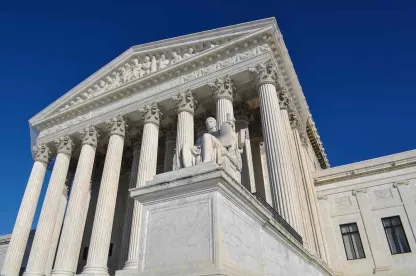By July 2022, the US Supreme Court is expected to release its opinion in American Hospital Association v. Becerra, a case that not only has significant ramifications for healthcare providers but may also impacts the deference all federal courts give to agency interpretations of ambiguous statutes (also known as the Chevron doctrine).
IN DEPTH
The US Supreme Court will issue its much-anticipated opinion in American Hospital Association v. Becerra by the end of its current term (June or July 2022). The American Hospital Association’s (AHA) appeal in the case challenges a decision by the US Court of Appeals for the District of Columbia Circuit upholding the US Department of Health and Human Services’ (HHS) final rule reducing Medicare reimbursement for 340B drugs. While the case has significant ramifications for many hospitals that participate in the 340B Program, the implications of the opinion may be much more broad. At its core, the case is not about payments for 340B drugs, it is a vehicle for the Supreme Court to consider the vitality and scope of the Chevron doctrine of judicial deference to agency interpretations of ambiguous statutes.
The Statutory Arguments in Depth
The 340B Program helps certain “covered entities”—including many hospitals—stretch scarce federal resources by allowing the entities to purchase certain eligible outpatient drugs from manufacturers at a discount.
The Social Security Act provides that the amount that the Centers for Medicare & Medicaid Services (CMS) pays hospitals for outpatient drugs under the Medicare Outpatient Hospital Prospective Payment System (OPPS) is equal:
-
“(I) to the average acquisition cost [(AAC)] for the drug for that year (which, at the option of the Secretary [of HHS], may vary by hospital group (as defined by the Secretary based on volume of covered [outpatient department] OPD services or other relevant characteristics)), as determined by the Secretary taking into account the hospital acquisition cost survey data under subparagraph (D); or
-
“(II) if hospital acquisition cost data are not available, the average price for the drug … as calculated and adjusted by the Secretary as necessary for purposes of this paragraph.” (42 U.S.C. §1395l(t)(14)(A)(iii)(I) – (II) (emphasis added).)
From 2006 to 2017, HHS calculated reimbursement rates based on the average sales price (ASP) of the drug. HHS used the ASP instead of the AAC of the drug because HHS lacked hospital acquisition cost survey data. This method resulted in all hospitals paid under OPPS, including 340B-participating hospitals paid under OPPS, receiving reimbursement equal to 104% to 106% of the ASP for outpatient drugs.
In 2018, HHS issued a final rule providing that HHS may reimburse 340B hospitals for outpatient drugs paid under OPPS at an amount intended to approximate the 340B-discounted AAC, rather than an amount based on ASP. The final rule recognized that the Secretary has the discretion to vary reimbursement by hospital group based on the volume of covered outpatient services or other relevant characteristics. It also provided that in cases of insufficient data, the HHS Secretary may “calculate and adjust the reimbursement amount as necessary for the purposes of the statute.” The final rule reduced payments to 340B hospitals to 77.6% of ASP, which was a reduction of approximately 30% from the 106% of ASP that they received previously.
AHA asserts that the rate change exceeds the bounds of an “adjustment” authorized by the statute. That is, AHA maintains that HHS lacks the statutory authority to base reimbursement on AAC in the absence of cost-survey data and cannot vary price-based rates by hospital group. According to AHA, Congress included the survey requirement to ensure accurate, consistent and transparent calculation of reimbursement rates. By eliminating that requirement, HHS acted in excess of its statutory authority and contrary to Congress’s intent.
AHA similarly argues that the final rule is not defensible under Chevron because the statute is clear and unambiguous. Congress required a cost survey if rates are based on AAC, or varied by hospital group, and Congress did not authorize HHS to waive the requirement.
AHA urges the Court to approach Chevron deference much like it approached Auer deference in Kisor v. Wilkie (139 S. Ct. 2400 (2019)). Auer deference is the judicial doctrine of deferring to an agency’s reasonable reading of its own genuinely ambiguous regulations. In Kisor, the Court retained the doctrine, but held that the lower courts must exhaust the canons of regulatory interpretation before applying the doctrine to genuinely ambiguous regulations.
AHA submits that the Court should similarly exhaust its statutory interpretation toolkit—taking into consideration the language, structure, operation and provenance of the 340B statute—before deferring to HHS’s interpretation of the statute under Chevron. The view of the AHA is that the statute is unambiguous and no resort to Chevron deference is necessary. If HHS wants to distinguish its reimbursement methodology across hospital categories, it must follow the statute and conduct a cost survey, or get Congress to change the law.
In contrast, HHS argues that the unambiguous statutory language gives HHS the discretion to set the reimbursement rate at AAC. If cost survey data is unavailable, then the Secretary of Health and Human Services may “calculate and adjust rates as necessary for the purposes of the statute.” The rate change is an adjustment that is supported by evidence and vindicates the purpose of the statute, which is to align reimbursement rates with acquisition costs as closely as possible. HHS maintains that the Court would reach the same outcome by applying Chevron, just as the D.C. Circuit did. The D.C. Circuit concluded that Congress had not unequivocally barred HHS from adjusting reimbursement, and HHS’s view was not patently unreasonable.
The Future of Chevron Deference
This case presents the Supreme Court with an opportunity to consider the vitality of Chevron and the limitations on its application. Indeed, some commentators were surprised that the Court granted certiorari in the case and assume that it did so in order to reassess Chevron (For a sample of these discussions, see here, here and here.).
The Court has several options available to it. First, affirm the decision and reasoning of the DC Circuit Court, which embraced a framing of Chevron that is favorable to the government. Second, overturn Chevron. Third, take a page from Kisor by preserving Chevron and reinvigorating the limits on its application. The second option would shift power from the executive branch to the legislative and judicial branches and create a stronger incentive for Congress to draft legislation that is both comprehensive and clear. The third option would as well, albeit to a lesser degree.
Amicus briefs were filed by a variety of stakeholders, including trade associations representing not only healthcare providers but also entirely different regulated industries. Many healthcare providers argued that 340B hospitals deliver care to underserved and disadvantaged patients, and therefore should not bear the brunt of a rate cut. Other healthcare providers (mainly hospitals ineligible for the 340B program) argued that HHS’s interpretation recaptures dollars that were previously reserved for 340B hospitals, and reallocates those dollars across all acute care hospitals paid under the OPPS system, which furthers the original goal of the OPPS system by incentivizing the efficient delivery of outpatient services.
Stakeholders outside of the healthcare industry typically opined on the scope and vitality of Chevron. Some argued that Chevron presents separation of powers concerns because it enlarges the executive branch at the expense of the legislative and judicial branches. The unintended consequence of Chevron is that it incentivizes Congress to pass ambiguous laws and avoid accountability by handing off complicated policy decisions to unelected agency personnel. Additional stakeholders argued that agency personnel may not be impartial and Chevron enables political interference with the implementing of statutes. Other stakeholders generally supported the preservation of Chevron and argued that it is consistent with separation of powers and does not lead to an expansion of the administrative state when applied appropriately.
At oral argument, the Supreme Court justices repeatedly raised questions about the vitality of Chevron. Justices Kagan, Sotomayor and Breyer raised questions suggesting that they do not believe that this is the case to overturn Chevron. Justices Gorsuch, Kavanaugh and Barrett questioned whether the ambiguity in the statute raises a simple interpretive question that the Court should resolve, or an issue requiring Chevron analysis and implicating delegation to an agency. None of the questioning suggested that a majority of the justices will vote to overrule Chevron.







 />i
/>i

